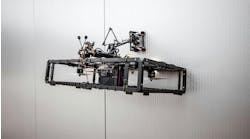Near-bit reaming tool allows continuous drilling, under-reaming
Flexible bottom hole assembly placement offers numerous directional drilling advantages.
Reaming and opening up wellbores with conventional drilling assemblies have always been difficult and problematic - at best. High downhole and surface torques usually accompany these drilling operations, yielding violent, transverse vibration on bottomhole assembly (BHA) components.
The destructive energy is sufficient to actually bring downhole tool components to failure limits prematurely. Everything from drill bit cones and shanks, reamer arms, stabilizer blades, to entire bottom hole assemblies has been left in the hole as a result of these destructive forces.
For this reason, under-reaming wellbores has often taken a back seat in well construction activities and been relegated to the clean-up wiper trip, prior to running casing. As the industry explores in greater water depths, drillstring trip time becomes even more important. Eliminating just one trip can save tens of thousands of dollars for the operator. For a reaming tool to work in these situations with operator confidence, a new design was needed. One alternative, is the new near-bit reaming tool from Security DBS, a division of Halliburton Energy Services.
The short, fully-stabilized Near Bit Reamer (NBR) can be used to drill oversized holes, more efficiently than with some bi-center bits, reaming-while-drilling tools, or other types of reamers. Unlike most bi-center bits and reaming-while-drilling tools, the NBR has been used on both conventional mud motor and rotary steerable directional assemblies.
Successful runs with the tool have been recorded offshore Norway. Five runs, in two different wells, including the record-setting run of 2,213 meters of continuous drilling/under-reaming in the second well have been performed.
North Sea proving
A Norwegian North Sea application used the NBR in conjunction with a rotary steerable drilling assembly to drill out float equipment, and complete two runs of about 300 meters each. The tool was then used in conjunction with a steerable, conventional mud motor assembly for a third run on this well, resulting in a total length of 1,400 meters of hole successfully opened to 13 3/4-in., while drilling a 12 1/4-in. hole.
In the second well, the tool was used with the same rotary steerable BHA, which drilled out the shoe and cement, then continued to drill and under-ream. The first run on this well had a total length of 2,213 meters, a record in simultaneous drilling and under-reaming. On the second run, the tool was used with a steerable, conventional mud motor assembly to total depth (TD) of the section. A total of 2,500 meters was drilled and under-reamed up to a size of 13 1/2-in. using the tool.
Technical operation
The NBR is specially designed for hole enlarging while drilling. The tool can be placed just above the bit, or higher in the BHA - for example, above a rotary steerable system. The tool is designed for optimum performance in directional applications where traditional hole opening techniques have proven difficult.
Unlike bi-center bits and reaming-while-drilling tools, the NBR is designed symmetrically with three cutter assemblies to provide balanced operation for smooth torque and minimal vibration. The tool can be used with any bit type, fixed cutter, or roller cone, to precisely match the formation and application for optimum drilling performance. The tool is hydraulically actuated, eliminating problems commonly associated with mechanically actuated tools.
There is no mechanical locking mechanism, thus preventing the arms from inadvertently sticking in the open position. The tool is also equipped with shear pins that prevent the cutting structure from opening while inside casing. This is highly favorable for drilling out float equipment. Once out from under casing, the shear pins retaining the arms can be sheared, allowing for opening the hole while drilling.
Applications, benefits
Hole opening can provide a number of efficiencies in well operations:
- The enlarged hole produces a lower equivalent circulating density (ECD) value under the same mud parameters and flow parameters.
- Hole opening allows for larger sized casing to be run, allowing for larger diameter pro duction holes without increased surface hole diameters.
- Use of a near bit reaming-while-drilling tool has shown to save significant rig time, thereby providing additional savings.
Traditional methods of hole enlargement underneath casing include under-reamers and most recently bi-center bits and reaming-while-drilling tools. While these tools have proven successful in many applications, their use in harsh environments and difficult directional applications have proven to provide less than desirable results.
Even in the harshest environments of the North Sea, the NBR has been used to successfully open up a 12 1/4-in. pilot hole to 13 1/2-in. and 13 3/4-in., while drilling directionally. A fewer number of BHA changes means reduced tripping time, more efficient operation and enhanced cost savings.
The NBR is one of the first reaming-while-drilling tools used with a rotary steerable system to drill oversized holes. The short, fully stabilized configuration of the NBR has low impact on steerability of directional assemblies, and produces minimal bottom hole assembly destructive vibrational energy. The tool in conjunction with a rotary system can significantly improve the economics of hole opening operations.




